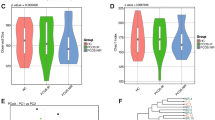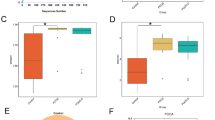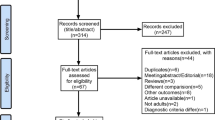Abstract
Previous studies had shown that the gut microbiota of polycystic ovary syndrome (PCOS) patients had significant differences from those of healthy individuals, which may play an important role in the pathogenesis of PCOS. Lifestyle intervention, such as nutritional intervention, could improve the metabolic profiles and PCOS-like phenotypes of PCOS patients. Meanwhile, nutritional intervention could rapidly alter and reshape the distribution of gut microbiota in individuals. Therefore, we sought to investigate the differences in gut microbiota in overweight and obese PCOS patients with or without nutritional intervention. Thirty-six overweight and obese PCOS patients were finally enrolled in the study. Eighteen individuals who refused nutritional intervention (RNI) were collected as the RNI group. Eighteen individuals who received the nutritional intervention were collected as the pre-NI group before the nutritional intervention. And they were also collected as the NI group after the nutritional intervention for 4–12 weeks. Significant decreases in BMI, FBG, TC, TG, APO A1, and APO B were observed when comparing the NI group with the pre-NI and RNI groups after the nutritional intervention for 4–12 weeks. Meanwhile, the differences in the phylum Firmicutes, Bacteroidetes, and the species Eubacterium rectale, Flavonifractor plautii, and Bacteroides vulgatus between the NI and the RNI groups were observed, which may be potentially linked to the improved inflammatory state and PCOS-like phenotypes of overweight and obese PCOS individuals.




Similar content being viewed by others
Data Availability
All the data in this paper support the results of this study.
Code Availability
Not applicable.
References
Escobar-Morreale HF. Polycystic ovary syndrome: definition, aetiology, diagnosis and treatment. Nat Rev Endocrinol. 2018;14(5):270–84. https://doi.org/10.1038/nrendo.2018.24.
De Sousa SMD, Norman RJP. Metabolic syndrome, diet and exercise. Best Pract Res Clin Obstet Gynaecol. 2016;37:140–51. https://doi.org/10.1016/j.bpobgyn.2016.01.006.
Vassilatou E. Nonalcoholic fatty liver disease and polycystic ovary syndrome. World J Gastroenterol. 2014;20(26):8351–63. https://doi.org/10.3748/wjg.v20.i26.8351.
Lim SS, Davies MJ, Norman RJ, Moran LJ. Overweight, obesity and central obesity in women with polycystic ovary syndrome: a systematic review and meta-analysis. Hum Reprod Update. 2012;18(6):618–37. https://doi.org/10.1093/humupd/dms030.
Qi X, Yun C, Sun L, Xia J, Wu Q, Wang Y, Wang L, Zhang Y, Liang X, Wang L, Gonzalez FJ, Patterson AD, Liu H, Mu L, Zhou Z, Zhao Y, Li R, Liu P, Zhong C, Pang Y, Jiang C, Qiao J. Gut microbiota-bile acid-interleukin-22 axis orchestrates polycystic ovary syndrome. Nat Med. 2019;25(8):1225–33. https://doi.org/10.1038/s41591-019-0509-0.
Rizk MG, Thackray VG. Intersection of polycystic ovary syndrome and the gut microbiome. J Endocr Soc. 2021;5(2):bvaa177. https://doi.org/10.1210/jendso/bvaa177.
Yurtdaş G, Akdevelioğlu Y. A new approach to polycystic ovary syndrome: the gut microbiota. J Am Coll Nutr. 2020;39(4):371–82. https://doi.org/10.1080/07315724.2019.1657515.
Gomes AC, Hoffmann C, Mota JF. The human gut microbiota: metabolism and perspective in obesity. Gut Microbes. 2018;9(4):308–25. https://doi.org/10.1080/19490976.2018.1465157.
Crovesy L, Masterson D, Rosado EL. Profile of the gut microbiota of adults with obesity: a systematic review. Eur J Clin Nutr. 2020;74(9):1251–62. https://doi.org/10.1038/s41430-020-0607-6.
Goodman NF, Cobin RH, Futterweit W, Glueck JS, Legro RS, Carmina E. American Association of Clinical Endocrinologists, American College of Endocrinology, and Androgen Excess and PCOS Society Disease State Clinical Review: guide to the best practices in the evaluation and treatment of polycystic ovary syndrome — part 2. Endocr Pract. 2015;21(12):1415–26. https://doi.org/10.4158/ep15748.Dscpt2.
Paoli A, Mancin L, Giacona MC, Bianco A, Caprio M. Effects of a ketogenic diet in overweight women with polycystic ovary syndrome. J Transl Med. 2020;18(1):104. https://doi.org/10.1186/s12967-020-02277-0.
Li C, Xing C, Zhang J, Zhao H, Shi W, He B. Eight-hour time-restricted feeding improves endocrine and metabolic profiles in women with anovulatory polycystic ovary syndrome. J Transl Med. 2021;19(1):148. https://doi.org/10.1186/s12967-021-02817-2.
Glueck CJ, Goldenberg N. Characteristics of obesity in polycystic ovary syndrome: etiology, treatment, and genetics. Metabolism. 2019;92:108–20. https://doi.org/10.1016/j.metabol.2018.11.002.
David LA, Maurice CF, Carmody RN, Gootenberg DB, Button JE, Wolfe BE, Ling AV, Devlin AS, Varma Y, Fischbach MA, Biddinger SB, Dutton RJ, Turnbaugh PJ. Diet rapidly and reproducibly alters the human gut microbiome. Nature. 2014;505(7484):559–63. https://doi.org/10.1038/nature12820.
Mardinoglu A, Wu H, Bjornson E, Zhang C, Hakkarainen A, Räsänen SM, Lee S, Mancina RM, Bergentall M, Pietiläinen KH, Söderlund S, Matikainen N, Ståhlman M, Bergh PO, Adiels M, Piening BD, Granér M, Lundbom N, Williams KJ, Romeo S, Nielsen J, Snyder M, Uhlén M, Bergström G, Perkins R, Marschall HU, Bäckhed F, Taskinen MR, Borén J. An integrated understanding of the rapid metabolic benefits of a carbohydrate-restricted diet on hepatic steatosis in humans. Cell Metab. 2018;27(3):559-571.e5. https://doi.org/10.1016/j.cmet.2018.01.005.
The Rotterdam ESHRE/SRM-sponsored PCOS consensus workshop group. Revised 2003 consensus on diagnostic criteria and long-term health risks related to polycystic ovary syndrome (PCOS). Hum Reprod. 2004;19(1):41–7. https://doi.org/10.1093/humrep/deh098.
Zhou BF. Predictive values of body mass index and waist circumference for risk factors of certain related diseases in Chinese adults—study on optimal cut-off points of body mass index and waist circumference in Chinese adults. Biomed Environ Sci. 2002;15(1):83–96.
Chen S, Zhou Y, Chen Y, Gu J. fastp: an ultra-fast all-in-one FASTQ preprocessor. Bioinformatics. 2018;34(17):i884–90. https://doi.org/10.1093/bioinformatics/bty560.
Li H, Durbin R. Fast and accurate short read alignment with Burrows-Wheeler transform. Bioinformatics. 2009;25(14):1754–60. https://doi.org/10.1093/bioinformatics/btp324.
Li D, Liu CM, Luo R, Sadakane K, Lam TW. MEGAHIT: an ultra-fast single-node solution for large and complex metagenomics assembly via succinct de Bruijn graph. Bioinformatics. 2015;31(10):1674–6. https://doi.org/10.1093/bioinformatics/btv033.
Hyatt D, Chen GL, Locascio PF, Land ML, Larimer FW, Hauser LJ. Prodigal: prokaryotic gene recognition and translation initiation site identification. BMC Bioinformatics. 2010;11:119. https://doi.org/10.1186/1471-2105-11-119.
Fu L, Niu B, Zhu Z, Wu S, Li W. CD-HIT: accelerated for clustering the next-generation sequencing data. Bioinformatics. 2012;28(23):3150–2. https://doi.org/10.1093/bioinformatics/bts565.
Li R, Li Y, Kristiansen K, Wang J. SOAP: short oligonucleotide alignment program. Bioinformatics. 2008;24(5):713–4. https://doi.org/10.1093/bioinformatics/btn025.
Qin N, Yang F, Li A, Prifti E, Chen Y, Shao L, Guo J, Le Chatelier E, Yao J, Wu L, Zhou J, Ni S, Liu L, Pons N, Batto JM, Kennedy SP, Leonard P, Yuan C, Ding W, Chen Y, Hu X, Zheng B, Qian G, Xu W, Ehrlich SD, Zheng S, Li L. Alterations of the human gut microbiome in liver cirrhosis. Nature. 2014;513(7516):59–64. https://doi.org/10.1038/nature13568.
Buchfink B, Xie C, Huson DH. Fast and sensitive protein alignment using DIAMOND. Nat Methods. 2015;12(1):59–60. https://doi.org/10.1038/nmeth.3176.
Kanehisa M, Sato Y, Kawashima M, Furumichi M, Tanabe M. KEGG as a reference resource for gene and protein annotation. Nucleic Acids Res. 2016;44(D1):D457–62. https://doi.org/10.1093/nar/gkv1070.
Burr JF, Rowan CP, Jamnik VK, Riddell MC. The role of physical activity in type 2 diabetes prevention: physiological and practical perspectives. Phys Sportsmed. 2010;38(1):72–82. https://doi.org/10.3810/psm.2010.04.1764.
Francula-Zaninovic S, Nola IA. Management of measurable variable cardiovascular disease’ risk factors. Curr Cardiol Rev. 2018;14(3):153–63. https://doi.org/10.2174/1573403x14666180222102312.
Romero-Gómez M, Zelber-Sagi S, Trenell M. Treatment of NAFLD with diet, physical activity and exercise. J Hepatol. 2017;67(4):829–46. https://doi.org/10.1016/j.jhep.2017.05.016.
Moran LJ, Noakes M, Clifton P, Buckley J, Brinkworth G, Thomson R, Norman RJ. Predictors of lifestyle intervention attrition or weight loss success in women with polycystic ovary syndrome who are overweight or obese. Nutrients. 2019;11(3). https://doi.org/10.3390/nu11030492.
Salva-Pastor N, López-Sánchez GN, Chávez-Tapia NC, Audifred-Salomón JR, Niebla-Cárdenas D, Topete-Estrada R, Pereznuñez-Zamora H, Vidaltamayo-Ramírez R, Báez-Arellano ME, Uribe M, Nuño-Lámbarri N. Polycystic ovary syndrome with feasible equivalence to overweight as a risk factor for non-alcoholic fatty liver disease development and severity in Mexican population. Ann Hepatol. 2020;19(3):251–7. https://doi.org/10.1016/j.aohep.2020.01.004.
Macut D, Tziomalos K, Božić-Antić I, Bjekić-Macut J, Katsikis I, Papadakis E, Andrić Z, Panidis D. Non-alcoholic fatty liver disease is associated with insulin resistance and lipid accumulation product in women with polycystic ovary syndrome. Hum Reprod. 2016;31(6):1347–53. https://doi.org/10.1093/humrep/dew076.
Rocha ALL, Faria LC, Guimarães TCM, Moreira GV, Cândido AL, Couto CA, Reis FM. Non-alcoholic fatty liver disease in women with polycystic ovary syndrome: systematic review and meta-analysis. J Endocrinol Invest. 2017;40(12):1279–88. https://doi.org/10.1007/s40618-017-0708-9.
Cai J, Wu CH, Zhang Y, Wang YY, Xu WD, Lin TC, Li SX, Wang LH, Zheng J, Sun Y, Liu W, Tao T. High-free androgen index is associated with increased risk of non-alcoholic fatty liver disease in women with polycystic ovary syndrome, independent of obesity and insulin resistance. Int J Obes (Lond). 2017;41(9):1341–7. https://doi.org/10.1038/ijo.2017.116.
Ley RE, Turnbaugh PJ, Klein S, Gordon JI. Microbial ecology: human gut microbes associated with obesity. Nature. 2006;444(7122):1022–3. https://doi.org/10.1038/4441022a.
Wang Y, Wan X, Wu X, Zhang C, Liu J, Hou S. Eubacterium rectale contributes to colorectal cancer initiation via promoting colitis. Gut Pathog. 2021;13(1):2. https://doi.org/10.1186/s13099-020-00396-z.
Mikami A, Ogita T, Namai F, Shigemori S, Sato T, Shimosato T. Oral administration of Flavonifractor plautii attenuates inflammatory responses in obese adipose tissue. Mol Biol Rep. 2020;47(9):6717–25. https://doi.org/10.1007/s11033-020-05727-6.
Liu M, Gao J, Zhang Y, Li P, Wang H, Ren X, Li C. Serum levels of TSP-1, NF-κB and TGF-β1 in polycystic ovarian syndrome (PCOS) patients in northern China suggest PCOS is associated with chronic inflammation. Clin Endocrinol (Oxf). 2015;83(6):913–22. https://doi.org/10.1111/cen.12951.
Rudnicka E, Suchta K, Grymowicz M, Calik-Ksepka A, Smolarczyk K, Duszewska AM, Smolarczyk R, Meczekalski B. Chronic low grade inflammation in pathogenesis of PCOS. Int J Mol Sci. 2021;22(7). https://doi.org/10.3390/ijms22073789.
Snider AP, Wood JR. Obesity induces ovarian inflammation and reduces oocyte quality. Reproduction. 2019;158(3):R79-r90. https://doi.org/10.1530/rep-18-0583.
Cincione RI, Losavio F, Ciolli F, Valenzano A, Cibelli G, Messina G, Polito R. Effects of mixed of a ketogenic diet in overweight and obese women with polycystic ovary syndrome. Int J Environ Res Public Health. 2021;18(23). https://doi.org/10.3390/ijerph182312490.
Acknowledgements
We appreciate the contributions of all participants in this study.
Funding
This work was supported by the National Key Research and Development Program of China (2021YFC2700700), Research Unit of Gametogenesis and Health of ART-Offspring, Chinese Academy of Medical Sciences (2020RU001), Natural Science Foundation of Shandong Province of China (ZR2020MH065), and Taishan Scholars Program for Young Experts of Shandong Province (tsqn201909195), Shandong Provincial Key Research and Development Program (2020ZLYS02).
Author information
Authors and Affiliations
Contributions
Conceptualization and formal analysis: LF, YL, and LC; method: YB, QW, and JL; data curation: LF, YL, and JL; sample collection: LF, TZ, XZ, and YB; funding acquisition: LC and ZC; LF was a major contributor in writing the manuscript. All authors read and approved the final manuscript.
Corresponding author
Ethics declarations
Ethics Approval
The study was approved by the institutional review board for the Center for Reproductive Medicine at Shandong University.
Consent to Participate
Informed consent was obtained from all participants.
Consent for Publication
All the authors read and approved the final manuscript.
Conflict of Interest
The authors declare no competing interests.
Additional information
Publisher's Note
Springer Nature remains neutral with regard to jurisdictional claims in published maps and institutional affiliations.
Supplementary Information
Below is the link to the electronic supplementary material.
Rights and permissions
Springer Nature or its licensor (e.g. a society or other partner) holds exclusive rights to this article under a publishing agreement with the author(s) or other rightsholder(s); author self-archiving of the accepted manuscript version of this article is solely governed by the terms of such publishing agreement and applicable law.
About this article
Cite this article
Fu, L., Li, Y., Bian, Y. et al. The Nutritional Intervention Improves the Metabolic Profile of Overweight and Obese PCOS Along with the Differences in Gut Microbiota. Reprod. Sci. 30, 2210–2218 (2023). https://doi.org/10.1007/s43032-022-01131-6
Received:
Accepted:
Published:
Issue Date:
DOI: https://doi.org/10.1007/s43032-022-01131-6




